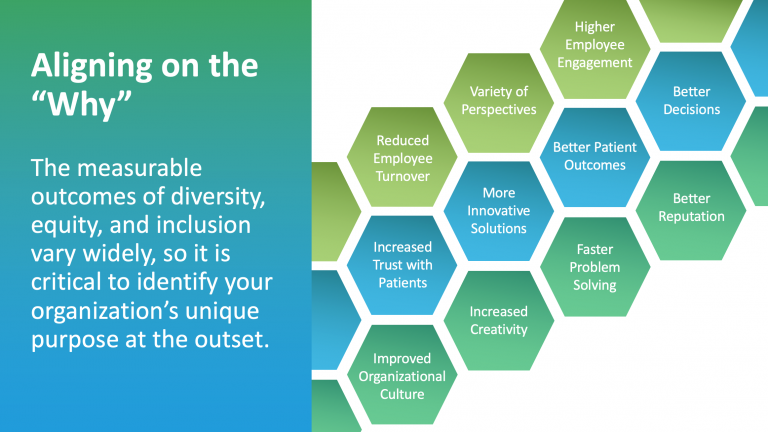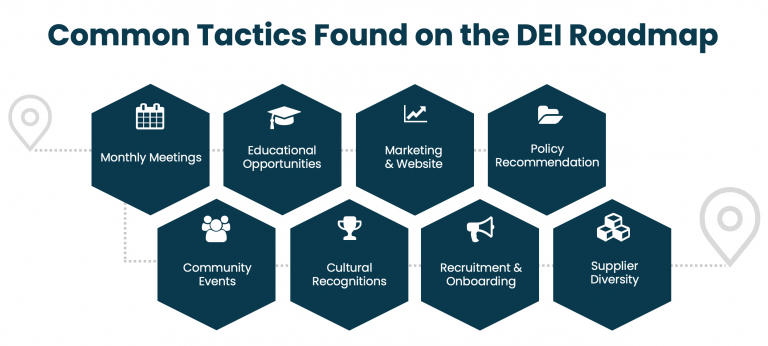Diversity, Equity, & Inclusion journey: Where to start
In this insight we will describe the factors that led to the recent uptick in focus on DEI across organizations of all kinds, the benefits of engaging in DEI work for your team members and patient populations alike, and a framework to guide you on your DEI journey with tools and tips to get you started.
Diversity, Equity, & Inclusion (DEI) is a topic that has gained increased focus worldwide in the past 18 months, as the dual pandemics of COVID-19 and systemic racism collided. In reaction to the murders of George Floyd and Breonna Taylor, protests erupted worldwide, and the public perception of racial justice and police brutality shifted significantly. While this awakening in public perception is important – it is also long overdue. Centuries of racist policies, both explicit and implicit, have taken a toll on their recipients in a multitude of ways. For example, in America racial minorities receive less public education funding, receive a lower quality of medical care, and earn disproportionately less income than their white counterparts. In the UK, minority ethnic groups are disproportionately targeted as crime suspects, a persistent issue in the 35 years since the introduction of stop and search legislation, according to a recent government report. The report also shares that in 2019 and 2020, Black, Asian and minority ethnic (BME) people were over four times more likely to be stopped and searched in the UK than white people.
So why after so many years did this awakening happen specifically in 2020? In addition to the visceral shock of the violence against George Floyd and Breonna Taylor, the pandemic starkly highlighted current health inequities, with racial and minority ethnic groups at higher risk of getting sick and dying from COVID-19 in the US and more likely to receive unclear information about COVID-19 safety protocols in the UK. There was also a rise in anti-Asian violence due to the origin of the coronavirus. It was impossible to follow news on the pandemic without also seeing its disproportionate impact on Black, Brown, and Asian communities. Additionally, for many during the pandemic, a reduction in social obligations, commute time, and even unemployment led to an increase in time devoted to absorbing the racial injustices of the pandemic and police brutality.
Collectively, these reflections have manifested in a widespread culture reset (read our related insight COVID-19 Business Response – Phase 4: The Great Culture Reset) within many organizations, with empathy at its core. Businesses within the healthcare industry and beyond have had to become more other-centered and invest more in the personal lives and struggles of their team members. Employees and customers are demanding their organizations step up and show commitment to this space. And organizations are acknowledging the importance of focusing on DEI to increase engagement, morale, and trust amongst current team members and to attract top talent in this highly competitive environment.
Consequently, organizations of all sizes are now turning a spotlight on DEI initiatives but are often unsure of where to start. DEI is a topic of substantial history and breadth that will not be solved overnight, and of course, taking the first step can feel overwhelming. Regardless of where your organization is on this journey – the work is no longer an option, but a necessity. In this insight, we will cover why any organization will benefit from engaging your team in DEI, how to take the first step in your unique journey, and the key considerations to think through when embedding DEI in your organization for the long-term.
What are the benefits of embedding DEI in an organization?
Engagement
Employees are looking beyond the traditional compensation and benefits factors as they consider their next career move. Today, a strong company culture, a clear purpose, and engaging learning opportunities are key to jobseekers’ decision-making process, and once they land at an organization, those same topics remain central to their engagement and retention. Employees across organizations and industries want to see their employer fostering DEI at work, and they are holding their employers accountable to create lasting change.
- Increased trust in growth opportunities: For some companies, change starts at examining the leadership level. Emerging leaders and top performers want to see themselves reflected in all areas of the organization. When we consider that today “97% of senior executive boards in the US fail to reflect the country’s labor force and population demographics and more than half of the FTSE 100 companies in the UK did not have minority representation on its board, it is clear we have a long way to go. In cases where shifting the demographics of leadership may take time, leaders can empower their employees by delegating decision-making power around DEI initiatives to smaller teams and individual contributors with diverse backgrounds and passion in this area.
- Increased performance: In the US, 83% of millennials reported higher levels of engagement when they believed their organization fosters an inclusive culture. Similarly in the UK, when a culture is inclusive, companies report 58% higher engagement, as measured by their employee Net Promoter Score.
Financial
For many companies, a DEI journey begins as an ethical imperative and with a goal for increasing team engagement, but what is sometimes less apparent is the competitive advantage and financial upside of prioritizing DEI.
- Higher revenue: Ethnically diverse companies are 35% more likely to yield higher revenue, while gender diverse companies are 15% more likely to yield higher revenue.
- Increased earnings: In the US, companies that increase racial and ethnic diversity on senior boards enjoy a 0.8% increase in earnings before interest and tax (EBIT), while their counterparts in the UK see a 3.5% increase.
- Increased profitability: An international survey across 15 countries and more than 1,000 large companies found that companies in the top quartile for gender diversity on executive teams were 25% more likely to have above-average profitability than companies in the fourth quartile, up from 21% in 2017.
Innovation and creativity
Engaging in DEI work at a company level allows for greater innovation by building “the capacity of psychological safety for people with different ideological orientations – and in doing so, advance the ability to constructively engage with the myriad ways in which people see the world.”
- Increased overall performance and innovation: In a recent Harvard Business Review article, Sylvia Ann Hewlett, Melinda Marshall, and Laura Sherbin identified and highlighted companies with what they called “two-dimensional diversity.” The leaders of these businesses had at least three inherent diversity traits and three acquired ones (culled from experience). By correlating diversity in leadership with market outcomes as reported by respondents, we learned that companies with 2-D diversity out-innovate and out-perform others.
- Increased innovation: In a study published in Innovation: Management, Policy & Practice, the authors analyzed levels of gender diversity in research and development teams from 4,277 companies in Spain. Using statistical models, they found that companies with more women were more likely to introduce radical new innovations into the market over a two-year period.
Innovation depends on a variety of perspectives and ideologies and is especially important in the healthcare industry, which is constantly adapting and changing to meet the needs of a growing patient population. New and brilliant innovation is not possible without inviting people with different experiences to the table and creating a safe space to share ideas.
One real world example of innovation in healthcare made possible by DEI is the creation of “Mind the Gap,” a manual that shows how different skin conditions look on darker skin by Malone Mukwende. Mukwende has been working with faculty at the St. George’s University of London to develop this manual as part of a student-staff partnership grant. He highlighted that, as a Black student, he felt alienated by the lack of discussion around clinical signs on darker skin. In providing Mukwende the grant, the university acknowledged this was a “very important issue and essential part of decolonizing the curriculum.”
Where to start: Define your intended outcomes
As outlined above, a focus on DEI is a non-negotiable for today’s workforce; however, given the breadth of the topic, it can be overwhelming to pinpoint where to start making a difference within your organization.
Every organization is in a different place on its DEI journey. If you are starting from scratch, we recommend that you first define your company’s intention behind starting up a DEI program. What are you trying to achieve and why? The measurable outcomes of a successful diversity, equity, and inclusion strategy vary widely, so it is critical to identify your company’s unique purpose at the outset, and then build your complete DEI strategy to support it. Examples of organizational outcomes are shown below, several of which were discussed in more detail in the previous section:

Source: Builtin
Continuing the journey
DEI is complex, and the way that organizations approach it will vary. We view the implementation of DEI initiatives as a six-step journey:
1. Building the business case: Using available demographic and organizational data, summarize the current state of workforce to inform DEI planning.
Note: It is important to consider your organizational investment at this initial step. Your DEI journey may not require a dedicated budget during its early stages, but planning for future spend is important. You will need to invest money for these initiatives to have impact across the broader organization (e.g. on dedicated resources, company events, etc.). Investing in DEI just like any other business priority allows it to be woven into the fabric of an organization.
2. Assessing where you are: Understanding current state from multi-level perspectives is critical to developing robust and tailored strategy that is uniquely for your organization.
3. Setting and prioritizing goals: Partnering with leadership to define the short and long-term goals across different components to increase DEI maturity. These goals should align to the broader outcomes that you defined upon starting your journey.
4. Charting a roadmap: Identifying activities and milestones to achieve DEI goals, including opportunities for reassessment at key intervals.

5. Executing on the roadmap: Collaborating with key stakeholders to action upon the roadmap to attain success towards DEI goals.
Note on resourcing: The natural question after developing a roadmap is, “Who is going to execute this work?” A common error is to begin a DEI journey and then solely rely on minority team members to lead the work in a volunteer capacity. While it’s important to have the voices of minority team members at the table, the effort of progressing DEI should not sit squarely on their shoulders. If your organization is not yet able to make DEI a formal role, be sure to engage many different team members from multiple areas and levels of the organization to share the workload and make a plan to ensure these efforts are recognized and rewarded appropriately. This could look like a compensation model for DEI leaders or allocating part of a team member’s responsibilities to include DEI work.
6. Recognizing success: Provide long-term playbook for the ongoing evaluation of DEI successes and opportunities.
As a leader, although the context of DEI implementation may be new, the above process and steps should feel familiar. It is important to apply the same rigor behind DEI initiatives as you would any transformational initiative within your organization. It is important you and your leadership team are vocal about your buy-in and advocacy of this work; your employees will be looking to you to lead by example. It is vital that you make time to actively participate in DEI-focused tactics within the roadmap, that you are intentional about your own learning process, and that you model vulnerability and willingness to grow in situations where you may not have the answer.
Keep in mind that no matter where your organization is on your DEI journey, it is helpful to incorporate “quick wins” while you’re working on the bigger picture and long-term strategy. For example, if mitigating unconscious bias is a need in your organization, you could bring in external support for an implicit bias workshop. Or, if it seems employee engagement is low, consider hosting a town hall to share your commitment and increased focus on DEI. Remember that initiatives are tools that ultimately help drive a broader DEI strategy, but they cannot stand alone. These initiatives will help open the door to internal conversations and invite engagement among team members. To tie long term strategy together with quick wins, focus on transparent and timely communications to keep the broader organization informed and engaged every step of the way.
Conclusion
The broader societal discussion around Diversity, Equity, and Inclusion and the momentum of relevant programs in the workplace is long overdue. While the social justice case for organizational DEI initiatives is undeniable, successful initiatives also have a tangible impact on your organization’s engagement, financials, and innovation. We encourage you as leaders to reflect on the state of DEI in your organization and where you are in your journey.
Vynamic’s Diversity, Equity, & Inclusion service helps clients define and support DEI within their organization to enhance business strategy, organizational dynamics, and team member experience. To explore how Vynamic can help your organization achieve its DEI goals, please contact DEI Service Leads Shannon Connolly and Stefanie Christmas.

Hello world!
References.
See all references and end notes on pg.6 here.
About Vynamic
Vynamic, an Inizio Advisory company, is a leading management consulting partner to global health organizations across Life Sciences, Health Services, and Health Technology. Founded and headquartered in Philadelphia, Vynamic has offices in Boston, Durham NC, New York, and London. Our purpose is simple: We believe there is a better way. We are passionate about shaping the future of health, and for more than 20 years we’ve helped clients transform by connecting strategy to action.
Through a structured, yet flexible delivery model, our accomplished leaders work as an extension of client teams, enabling growth, performance, and culture. Vynamic has been recognized by organizations like Great Place to Work and Business Culture Awards for being leaders and innovators in consulting, company culture, and health. Visit Vynamic.com to discover how we can help transform your
organization or your career.
Want to learn more? Get in touch!
Other insights.
Jump to a slide with the slide dots.
Scenario Planning Infographic
Boost launch readiness with scenario planning. Learn 5 steps to stay proactive in today’s unpredictable market. Download the infographic.
Read moreAI-Powered Decision Making to Simplify Your Launch Journey: Vynamic Experts on LaunchNav
LaunchNav by Inizio simplifies pharma launches with AI-driven insights, real-time benchmarks, and 800+ launch learnings.
Read moreThe One Big Beautiful Bill Act: Implications for the U.S. Health Industry
OBBBA reshapes U.S. healthcare with $1.2T cuts, shifting risk to providers, payers, and pharma. Explore impacts and strategies.
Read more
